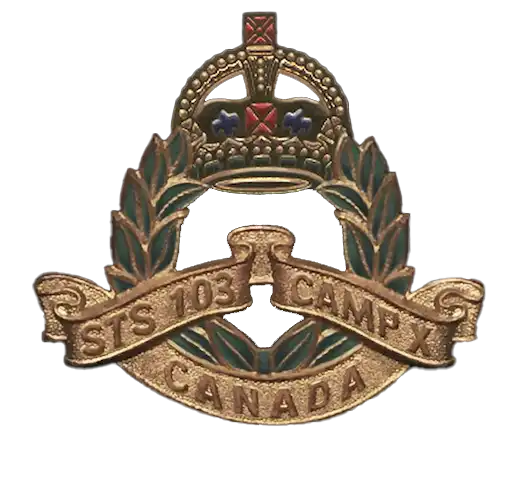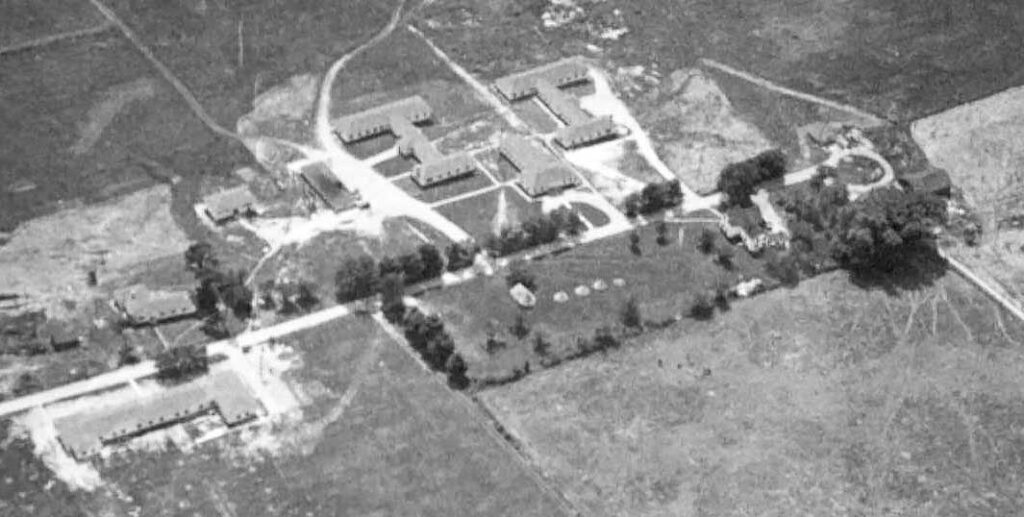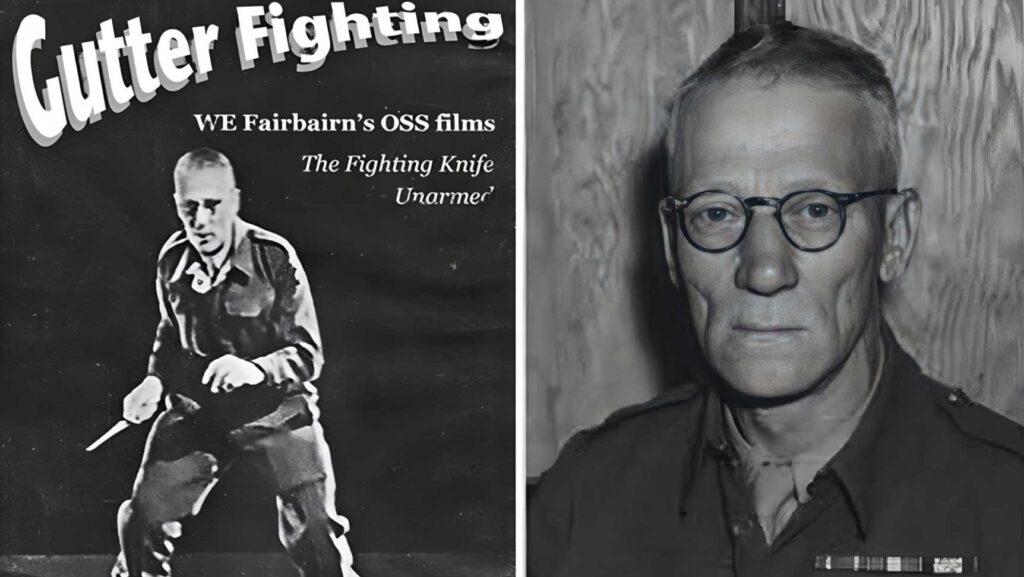Table of Contents
Formation
Camp X, also known as Special Training School (STS) #103, was established 6 December 1941 on a 260+ acre farm located on the northwestern shore of Lake Ontario between Whitby and Oshawa. The camp location was a quiet place with trees, bush, swamp, water and some rocky areas—ideal for commando training.
The original suggested locations for Camp X were either in PEI or Nova Scotia. The selected location, across the lake from New York state, with ready transportation access between Washington, New York, Ottawa and Toronto, was ultimately considered to be more convenient.

Vancouver businessman A.J. Taylor, a business acquaintance of William Stephenson’s, put together the land deal for Camp X in 1941 and hired the contractor (his brother) to build the buildings. With the exception of an old, eight-room farmhouse and outbuildings used for storage, which remained, the remainder of the camp was built in a matter of months during 1941 as one story, barracks-style accommodations.
Camp X was designed partly to link Britain and the US through British Security Coordination (BSC) which was headquartered in New York. BSC had been set up by the British Secret Intelligence Service (MI6) in New York in 1940 at Winston Churchill’s direction. However, it was under the auspices of William Stephenson, whose official title was Passport Control Officer. His actual role was far greater than that.
Although Stephenson is identified in some documents as the first Camp Commandant and was certainly a catalyst behind the camp being established, the first Camp X Commandant was LCol Terrence Roper-Caldbeck from the (British) Argyll and Sutherland Highlanders. He joined the Special Operations Executive (SOE), a commando and agent training organization, in August 1941. He was sent to Canada to train agents from the Special Operations Executive (SOE), Federal Bureau of Investigation (FBI) and Office of Strategic Services (OSS) for clandestine sabotage and espionage missions.
Major Bill Brooker was the Chief Instructor and second Camp Commandant from December 1942 to 1943. LCol Terrence Skilbeck was the last Commandant from 1943 to 1944. The camp was staffed mainly by British soldiers from the SOE and Canadian soldiers under BSC auspices.

The SOE had been formed to conduct espionage, sabotage and reconnaissance in occupied Europe and to recruit and assist local resistance units. The FBI was allowed to train some agents at least partly to appease J. Edgar Hoover, who regarded the BSC and OSS with some suspicion.
The OSS was formed under the command of Col (later General) Bill Donovan as Director and it later became the CIA (1947). Donovan and Stephenson, both 1WW heroes and well-connected, had known and respected each other since the Great War. The training the fledgling OSS received at Camp X became the training curriculum for subsequent OSS and CIA training in the US. Donovan once said, “Bill Stephenson taught us all we ever knew about foreign intelligence”.
The OSS training schools were modelled after the STS. Several early OSS agents completed some of the initial courses delivered at Camp X. Support for this type of training was enhanced by the delivery of intensive weekend courses by STS 103 for OSS Executives and Desk Officers.
Training
The school purpose was to develop and to train agents in aspects of silent killing, sabotage, partisan work, recruitment methods for the resistance, demolition, map reading, small arms weaponry, and communications. Course sizes generally did not exceed 32 people in the beginning.
As training advanced into more specific sabotage and espionage areas, trainees were gradually weaned out. There were three groups of trainees in the SOE system: A, B and C. Some failed out of Group A, which was focused mostly on the paramilitary aspects, or because they failed to demonstrate some of the necessary skills. Those who passed Group A progressed to Group B courses where a similar elimination process with a different curriculum occurred. Those with exceptional talents progressed to Group C, the highest level, which focused on more refined (finishing) skills. The finishing schools were mostly in Britain.
Curriculum
Course candidates developed deciphering, encoding and encrypting skills, and learned hand-to-hand combat, small arms usage and knife-fighting skills. In advanced training, trainees learned parachuting, lock picking, police methods, interrogation, wireless radio operation, telegraphy and Morse code, disguise, cover stories, propaganda techniques, etc. The SOE often recruited operatives (e.g. refugees from occupied countries who had fled before the Germans arrived) fluent in more than one language who knew the geography in the occupied country.
Typically, training lasted at Camp X for 3 to 4 weeks per course. Camp X approximated a Group A school, with an emphasis on paramilitary training. However, it also had some elements of Group B training including enemy identification and agent recruitment. The training provided compressed elements of the SOE curriculum. It was more than a preliminary, but less than a finishing school.
About 500 overseas agents were trained over a 2+-year period. Camp X closed its school in April 1944. Several organizations (OSS, FBI, RCMP, Military Intelligence), ethnicities (American, British, French-Canadian, Yugoslav, Hungarian, Italian, Chinese) and countries USA, Britain, Canada, Holland, France) were involved.
Trainees who demonstrated particular skills with coding/decoding (cryptography) were often retained to work on Hydra. Agents were trained to intercept, decode, recode and transmit messages.
Police methods and countermeasures such as surveillance techniques, searches, burglary, and interrogation were taught. Clandestine rendezvous techniques for agents in the field were particularly important as the Germans had penetrated SOE networks in occupied Europe.
Trainees were also taught fundamental propaganda techniques, including reproduction and distribution, to help attract people in occupied countries to join the resistance (e.g. emphasizing children’s empty bellies instead of hunger; appealing to love of country instead of patriotism).
Instructors
Most of the school instructors were from the British Secret Intelligence Service who had been trained by the Special Operations Executive (SOE) in Scotland. Some of the instructors taught specialized skills and others supported the camp. Canadian soldiers were generally drivers and used for general duties around the camp.
One of the most prominent instructors at Camp X was LCol William Ewart Fairburn. He trained initially with the Royal Marine Light Infantry. Subsequently, he served over 32 years with the Shanghai Municipal Police (1907 – 40).
While in Shanghai, he learned several martial arts (Boxing, Wrestling, Savate, Jujitsu, Judo, Kung Fu) to create his own martial art form – Defendu. He was reputed to have been involved in over 600 non-training fights on Shanghai streets. He also developed a police SWAT team, established a Riot Squad, created a bullet-proof vest, and taught Defendu to police forces.

He was recruited by the British Secret Service and commissioned in 1940 (age 55). He trained SOE agents in Scotland from 1940 – 42 and became an Instructor at STS #103 at age 57 where he taught British, American, Canadian and Dutch commandos as well as Army Rangers and OSS Operatives in close (hand-to-hand) combat, pistol shooting and knife-fighting techniques (which he called gutter fighting). The essence of the gutter fighting technique he taught was no holds barred as these were generally life or death situations.
Fairbairn taught at Camp X until he was lent to Col Bill Donovan, the Coordinator of Information (COI), the forerunner to the Office of Strategic Services (OSS), to be a trainer. He became a legend with the OSS. He wrote several books on weapons use and self-defence. His books and tactics were used by Special Forces and commando teams for training and undoubtedly influence training to this day.
Perhaps Fairbairn is most known for inventing a double-edged, 6.5”, stiletto “commando” knife, along with his police colleague Sykes. This knife was and is used by many Special Forces soldiers and the US Marine Corps.

Hydra
The building shown housed the Camp X Hydra equipment. Hydra was a powerful radio station that sent and received key intelligence information the Allies used during World War II.
The main transmitter came from a radio station, and additional equipment came from amateur radio operators, some of whom worked at the camp to operate the equipment. The radio station was named Hydra from the multiple transmitting antennae protruding from the bank of at that time sophisticated radio gear.
Hydra played a vital role in maintaining the flow of information from Allied outposts in Europe with command centres in the U.K. and America. It was built from accumulated radio equipment which included a 10-kilowatt, high-frequency, water-cooled transmitter acquired from a Philadelphia radio station.
The Hydra complex was also equipped with a Rockex machine, an ingenious device developed by Canadian engineer, Benjamin (Pat) Bayly, that automated the encryption and decryption of messages. These were Allied messages encoded to avoid enemy interception.


Hydra was never used to decode intercepted German or Japanese transmissions. However, because of periodic atmospheric conditions, it was sometimes used to intercept signals from the Axis powers that couldn’t be picked up by receivers in the U.K. These transmissions were then sent to places like Bletchley Park, a site for British codebreakers, for decoding.
Pat Bayly
Benjamin deforest (Pat) Bayly was born in Ontario but his family relocated to Moose Jaw, Saskatchewan when he was an infant. He attended King George and Central Collegiate schools and subsequently attained a Law degree at the University of Saskatchewan. After obtaining the degree he practiced in Moose Jaw, but discovered he did not particularly like the law profession.
While in high school he had built a radio transmitter which was used to transmit a radio show. It was the beginning of CHAB radio and Pat was one of the founders of the station. He returned to school after practicing Law to study engineering at the University of Toronto. During his final year, he taught 1st, 2nd, and 3rd year engineering students and obtained a degree.
Pat’s contribution to the war effort during the Second World War started when he worked as an inventor at Stephenson’s British Security Coordination office in New York City and later at Camp X near Whitby, Ontario.
While in New York he modified a ciphering machine which was used at Camp X (code named Hydra) to send coded messages to Britain, New York, Ottawa and Washington. Hydra continued in use until the 1970s within embassy circles. Pat is credited with helping to bring 2WW to a close earlier than it would have been because of his work. He retired as a Colonel in the Canadian Army.
He was awarded the Order of the British Empire for his contributions to the war effort. Further, it has been suggested the character “M” in the Ian Fleming Bond books may have been based on Pay Bayly.
After the war, he established his own manufacturing company in Ajax, Ontario. He built the first automated mail sorting machine and contributed to work on the first artificial heart. He died in 1994 at age 90.
~Excerpts from Heritage Moose Jaw (1992) Inc. meeting, April 1
Communication Centre
The Camp X communications centre processed literally thousands of messages daily. By mid-1944, Hydra was transmitting 30,000 and receiving 9,000 message groups daily—much of the secret Allied intelligence traffic across the Atlantic. Many of these were passed on to the BSC in New York.
Many of the operators were Canadian civilians who had been ham radio operators before the war. Operators also included women. As one might expect, relations between the British instructors and Canadian civilians were sometimes strained because the civilians did not have the desired military discipline.
Females were not accommodated on the Camp X site. They were generally dropped off and picked up each day. No females were actually trained as agents at this school, although about 3,000 were trained at SOE schools in Britain.
After September 1944, the Canadian Army assumed the costs of all 63 Canadian Army personnel stationed at Camp X. The camp’s designation was changed to No. 2 Military Research Centre and an additional 30 personnel were hired. At this point the camp became more focused on signals intelligence.
In 1945, Stephenson determined it was necessary to produce a BSC history and Camp X seemed the ideal place because it was isolated and the BCS documents were sensitive enough that they could have damaged Anglo-American relations. However, rumours persisted because of the continuing secrecy and some locals thought the Camp had something to do with the atomic bomb.
Post-War
Igor Sergeyevich Gouzenko was a 26-year-old cipher clerk for the Soviet Embassy in Ottawa, Ontario. He defected on 5 September 1945 with 109 documents on Soviet espionage activities in the West.
In September 1945, hearing that he and his family were to be sent home to the Soviet Union and dissatisfied with the quality of life and the politics of his homeland, he decided to defect.
Initially, when he approached the RCMP, officers on duty refused to believe his story. He then went to the Ottawa Journal newspaper, but the paper’s night editor was not interested, and suggested he go to the Department of Justice – however nobody was on duty when he arrived.
The next day Gouzenko was able to find contacts in the RCMP who were willing to examine the documents he had removed from the Soviet embassy.
Prime Minister King did not want Canada to get involved with Gouzenko, but Stephenson argued strongly Gouzenko should not be ignored because of the information he possessed which would be valuable to the allies. Eventually, King agreed and the RCMP took Gouzenko into protective custody.
Gouzenko was transported by the RCMP to “Camp X” where he and his family lived from 1945 to 1947. While at Camp X, he was interviewed by Britain’s internal security service (MI5) and the FBI.
Gouzenko’s defection ushered in the modern era of Canadian security intelligence. The evidence provided by Gouzenko led to the arrest of 39 suspects. A total of 18 were eventually convicted of a variety of offences. There were Soviet sympathizers in high places in the Canadian government and British High Commission.
Gouzenko exposed Stalin’s efforts to steal nuclear secrets, and the technique of planting sleeper agents. The “Gouzenko Affair” is often credited as a triggering event of the Cold War. The Soviet spy ring in Canada alerted other countries around the world, such as the United States and the United Kingdom, that Soviet agents had almost certainly infiltrated their nations as well.
Intrepid Park
Following the war, the Camp X site was used by the Canadian military as a Soviet communications signals monitoring station. The Camp was sold by the Department of National Defence (DND) to the townships of Whitby and Oshawa in 1969 and the buildings were demolished in 1977.
The Intrepid Park and memorial, erected in 1984, is all that remains to acknowledge the presence of Camp X during the war years.
Myths
There are four myths about Camp X that have persisted.
- Two Czech/Slovak agents who assassinated Reinhard Heydrich in Prague on 27 May 1942 were trained there.
- Norwegian agents who destroyed the Norsk Hydro heavy-water plant at Vemork, Norway, were trained there.
- Two British radar specialists accompanying the Dieppe raid in August 1942 were trained there.
- Ian Fleming, author of the James Bond novels, was trained there.
However, logic and evidence suggest otherwise.
- Camp X opened 6 December 1941. The Heydrich assassination had been planned well before then and there had already been two, weather-related, abortive attempts to parachute the assassins into Czechoslovakia in November 1941. These agents were finally parachuted into Czechoslovakia on 28 December 1941—only three weeks after Camp X had opened.
- While SOE agents did temporarily destroy the heavy-water plant at Vemork in Norway they were not trained at Camp X. It would make no sense to have a group of commandos come to Canada just to take preliminary training when there were over 60 STS around the world and most of them a lot closer to Norway than Canada.
- This myth begs the question of why two British radar specialists would cross the Atlantic to learn about radar. There was, in fact, only one British RAF Flight Sergeant who accompanied the raid, but he didn’t find out anything about German radar. Subsequently, he claimed never to have been trained at Camp X.
- Ian Fleming was in British Naval Intelligence and did visit the BSC in New York. It is possible he might also have visited Camp X, but the Camp Commandants responsible for the training claim no one named Ian Fleming was trained there and there is also no record in the SOE files he trained there.
Information Sources – Camp X and BSC
- Hodgson, Lynn-Philip and Alan Paul Longfield, Camp X: The Final Battle
- Hyde, H. Montgomery, The Quiet Canadian: The Secret Service Story of Sir William Stephenson
- Macdonald, Bill, The True Intrepid: Sir William Stephenson and the Unknown Agents
- Stafford, David, Camp X: OSS, “Intrepid,” and the Allies’ North American Training Camp for Secret Agents, 1941-45
- Stevenson, William, A Man Called Intrepid: The Secret War
- Stevenson, William, Intrepid’s Last Case
- Numerous websites









